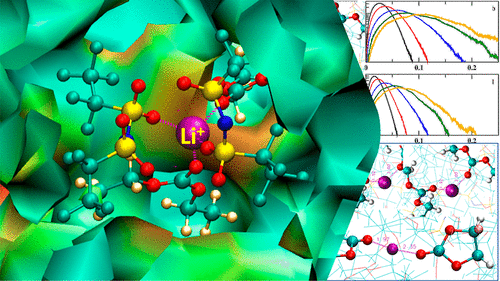当前位置:
X-MOL 学术
›
J. Phys. Chem. B
›
论文详情
Our official English website, www.x-mol.net, welcomes your
feedback! (Note: you will need to create a separate account there.)
Solvent-Assisted Li-Ion Transport and Structural Heterogeneity in Fluorinated Battery Electrolytes
The Journal of Physical Chemistry B ( IF 2.8 ) Pub Date : 2021-09-13 , DOI: 10.1021/acs.jpcb.1c05537 Th Dhileep N Reddy 1 , Bhabani S Mallik 1
The Journal of Physical Chemistry B ( IF 2.8 ) Pub Date : 2021-09-13 , DOI: 10.1021/acs.jpcb.1c05537 Th Dhileep N Reddy 1 , Bhabani S Mallik 1
Affiliation

|
The electrolytes diluted with fluorinated solvents show promising properties toward better battery technology than existing ones. The transport of Li ions in these fluorinated electrolytes is essential to access the performance of a battery. It is believed that the transport of the Li ion in these electrolytes occurs through polar solvents in the matrix of nonpolar solvent molecules. The atomistic details of this mechanism are yet to be proved using the dynamics of these mixtures. In this study, we performed classical molecular dynamics simulations at various temperatures to probe this mechanism through the structure and dynamics of electrolytes at the atomic level. Here, we have shown that the polar fluorinated solvents assist the Li-ion transport in a region of nonpolar solvent. Highly polar molecules also solvate the Li ion at a lower temperature. The nonpolar solvent solvates the Li ion weakly as compared to others. The calculated values of the ionic conductivity from the Green–Kubo relation provide a better match than that from an experimental conductivity meter. Furthermore, we probed the heterogeneity in the dynamics of the electrolytes by calculating the non-Gaussian parameter. We also show that the transport mechanism of the Li ion in diluted concentrated electrolytes is different than a few of the other reported electrolytes. We have also calculated the ion-pair and ion-cage lifetimes to see the most and least lived ion/ion–solvent pairs. The mechanism given from the present study may help to design the fluorinated electrolytes for Li-ion batteries.
中文翻译:

氟化电池电解质中溶剂辅助的锂离子传输和结构异质性
用氟化溶剂稀释的电解质显示出比现有技术更好的电池技术的有前途的特性。锂离子在这些氟化电解质中的传输对于获得电池的性能至关重要。据信,这些电解质中锂离子的传输是通过非极性溶剂分子基质中的极性溶剂发生的。这种机制的原子细节还有待使用这些混合物的动力学来证明。在这项研究中,我们在不同温度下进行了经典分子动力学模拟,以通过原子级电解质的结构和动力学来探索这种机制。在这里,我们已经证明极性氟化溶剂有助于非极性溶剂区域中的锂离子传输。高极性分子也在较低温度下溶解锂离子。与其他溶剂相比,非极性溶剂弱溶剂化锂离子。根据 Green-Kubo 关系计算出的离子电导率值比来自实验电导率计的值提供了更好的匹配。此外,我们通过计算非高斯参数来探讨电解质动力学的异质性。我们还表明,锂离子在稀释的浓缩电解质中的传输机制与其他一些报道的电解质不同。我们还计算了离子对和离子笼寿命,以查看寿命最长和寿命最短的离子/离子-溶剂对。本研究给出的机制可能有助于设计锂离子电池的氟化电解质。与其他溶剂相比,非极性溶剂弱溶剂化锂离子。根据 Green-Kubo 关系计算出的离子电导率值比来自实验电导率计的值提供了更好的匹配。此外,我们通过计算非高斯参数来探讨电解质动力学的异质性。我们还表明,锂离子在稀释的浓缩电解质中的传输机制与其他一些报道的电解质不同。我们还计算了离子对和离子笼寿命,以查看寿命最长和寿命最短的离子/离子-溶剂对。本研究给出的机制可能有助于设计锂离子电池的氟化电解质。与其他溶剂相比,非极性溶剂弱溶剂化锂离子。根据 Green-Kubo 关系计算出的离子电导率值比来自实验电导率计的值提供了更好的匹配。此外,我们通过计算非高斯参数来探讨电解质动力学的异质性。我们还表明,锂离子在稀释的浓缩电解质中的传输机制与其他一些报道的电解质不同。我们还计算了离子对和离子笼寿命,以查看寿命最长和寿命最短的离子/离子-溶剂对。本研究给出的机制可能有助于设计锂离子电池的氟化电解质。根据 Green-Kubo 关系计算出的离子电导率值比来自实验电导率计的值提供了更好的匹配。此外,我们通过计算非高斯参数来探讨电解质动力学的异质性。我们还表明,锂离子在稀释的浓缩电解质中的传输机制与其他一些报道的电解质不同。我们还计算了离子对和离子笼寿命,以查看寿命最长和寿命最短的离子/离子-溶剂对。本研究给出的机制可能有助于设计锂离子电池的氟化电解质。根据 Green-Kubo 关系计算出的离子电导率值比来自实验电导率计的值提供了更好的匹配。此外,我们通过计算非高斯参数来探讨电解质动力学的异质性。我们还表明,锂离子在稀释的浓缩电解质中的传输机制与其他一些报道的电解质不同。我们还计算了离子对和离子笼寿命,以查看寿命最长和寿命最短的离子/离子-溶剂对。本研究给出的机制可能有助于设计锂离子电池的氟化电解质。我们还表明,锂离子在稀释的浓缩电解质中的传输机制与其他一些报道的电解质不同。我们还计算了离子对和离子笼寿命,以查看寿命最长和寿命最短的离子/离子-溶剂对。本研究给出的机制可能有助于设计锂离子电池的氟化电解质。我们还表明,锂离子在稀释的浓缩电解质中的传输机制与其他一些报道的电解质不同。我们还计算了离子对和离子笼寿命,以查看寿命最长和寿命最短的离子/离子-溶剂对。本研究给出的机制可能有助于设计锂离子电池的氟化电解质。
更新日期:2021-09-23
中文翻译:

氟化电池电解质中溶剂辅助的锂离子传输和结构异质性
用氟化溶剂稀释的电解质显示出比现有技术更好的电池技术的有前途的特性。锂离子在这些氟化电解质中的传输对于获得电池的性能至关重要。据信,这些电解质中锂离子的传输是通过非极性溶剂分子基质中的极性溶剂发生的。这种机制的原子细节还有待使用这些混合物的动力学来证明。在这项研究中,我们在不同温度下进行了经典分子动力学模拟,以通过原子级电解质的结构和动力学来探索这种机制。在这里,我们已经证明极性氟化溶剂有助于非极性溶剂区域中的锂离子传输。高极性分子也在较低温度下溶解锂离子。与其他溶剂相比,非极性溶剂弱溶剂化锂离子。根据 Green-Kubo 关系计算出的离子电导率值比来自实验电导率计的值提供了更好的匹配。此外,我们通过计算非高斯参数来探讨电解质动力学的异质性。我们还表明,锂离子在稀释的浓缩电解质中的传输机制与其他一些报道的电解质不同。我们还计算了离子对和离子笼寿命,以查看寿命最长和寿命最短的离子/离子-溶剂对。本研究给出的机制可能有助于设计锂离子电池的氟化电解质。与其他溶剂相比,非极性溶剂弱溶剂化锂离子。根据 Green-Kubo 关系计算出的离子电导率值比来自实验电导率计的值提供了更好的匹配。此外,我们通过计算非高斯参数来探讨电解质动力学的异质性。我们还表明,锂离子在稀释的浓缩电解质中的传输机制与其他一些报道的电解质不同。我们还计算了离子对和离子笼寿命,以查看寿命最长和寿命最短的离子/离子-溶剂对。本研究给出的机制可能有助于设计锂离子电池的氟化电解质。与其他溶剂相比,非极性溶剂弱溶剂化锂离子。根据 Green-Kubo 关系计算出的离子电导率值比来自实验电导率计的值提供了更好的匹配。此外,我们通过计算非高斯参数来探讨电解质动力学的异质性。我们还表明,锂离子在稀释的浓缩电解质中的传输机制与其他一些报道的电解质不同。我们还计算了离子对和离子笼寿命,以查看寿命最长和寿命最短的离子/离子-溶剂对。本研究给出的机制可能有助于设计锂离子电池的氟化电解质。根据 Green-Kubo 关系计算出的离子电导率值比来自实验电导率计的值提供了更好的匹配。此外,我们通过计算非高斯参数来探讨电解质动力学的异质性。我们还表明,锂离子在稀释的浓缩电解质中的传输机制与其他一些报道的电解质不同。我们还计算了离子对和离子笼寿命,以查看寿命最长和寿命最短的离子/离子-溶剂对。本研究给出的机制可能有助于设计锂离子电池的氟化电解质。根据 Green-Kubo 关系计算出的离子电导率值比来自实验电导率计的值提供了更好的匹配。此外,我们通过计算非高斯参数来探讨电解质动力学的异质性。我们还表明,锂离子在稀释的浓缩电解质中的传输机制与其他一些报道的电解质不同。我们还计算了离子对和离子笼寿命,以查看寿命最长和寿命最短的离子/离子-溶剂对。本研究给出的机制可能有助于设计锂离子电池的氟化电解质。我们还表明,锂离子在稀释的浓缩电解质中的传输机制与其他一些报道的电解质不同。我们还计算了离子对和离子笼寿命,以查看寿命最长和寿命最短的离子/离子-溶剂对。本研究给出的机制可能有助于设计锂离子电池的氟化电解质。我们还表明,锂离子在稀释的浓缩电解质中的传输机制与其他一些报道的电解质不同。我们还计算了离子对和离子笼寿命,以查看寿命最长和寿命最短的离子/离子-溶剂对。本研究给出的机制可能有助于设计锂离子电池的氟化电解质。











































 京公网安备 11010802027423号
京公网安备 11010802027423号